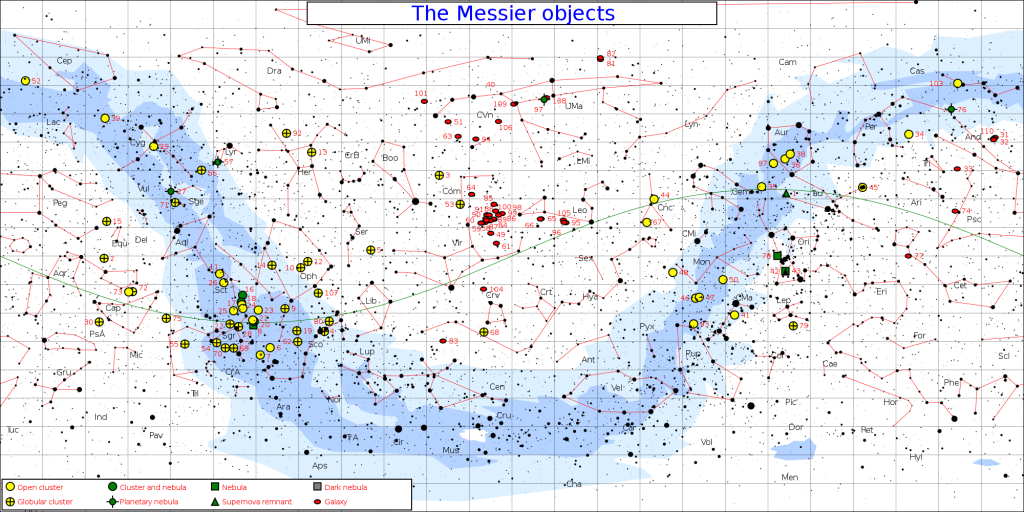Messier objects are a group of deep sky objects catalogued by the French astronomer and comet-hunter Charles Messier in the late 18th century.
Messier’s Catalogue des Nébuleuses et des Amas d’Étoiles (Catalogue of Nebulae and Star Clusters) is a collection of deep sky objects (galaxies, nebulae, star clusters) and other astronomical objects (asterisms, binary stars) visible with binoculars and telescopes. It is the best-known astronomy catalogue that is still in popular use. It serves as a guide for visual astronomy for amateur astronomers and astronomy clubs around the world.
Messier compiled the list between 1758 and 1782. His original goal was to list the objects that were frequently mistaken for comets. Messier was a comet hunter, which was a popular activity among 18th century astronomers, and this led him to create the first comprehensive list of deep sky objects that frustrated his search.
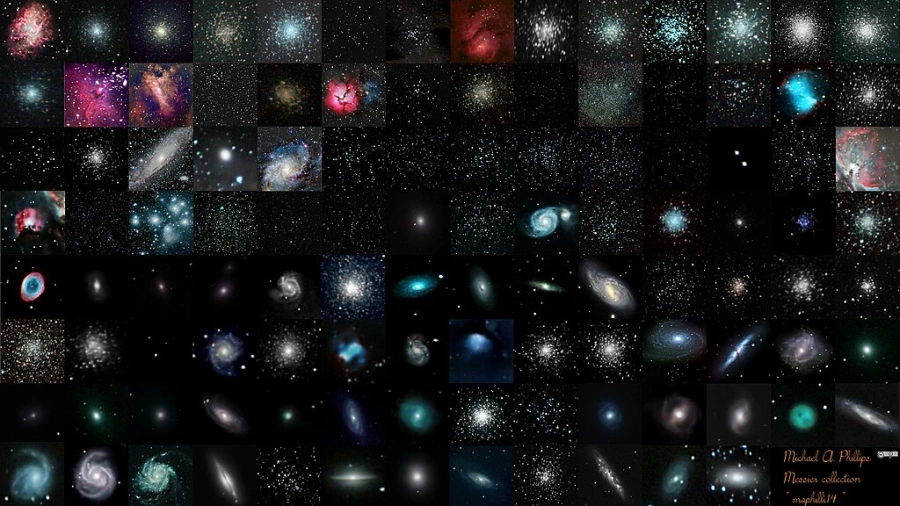
The 110 Messier objects, image: Wikimedia Commons/Michael A. Phillips (CC BY 4.0)
The Italian astronomer Giovanni Hodierna had compiled a similar catalogue of astronomical objects, about 40 of them, and published it in 1654. However, his work had no major impact on Messier and the French astronomer was likely unaware of it.
Messier objects are popular targets among amateur astronomers because they are relatively bright and easy to find and observe in small telescopes. Messier himself used a relatively small refractor telescope (4 inch, or 100 mm) for his observations. In the early spring, all the objects can be seen over the course of a single night.
Messier made his observations from Paris, France. For this reason, the Messier catalogue doesn’t include any prominent deep sky objects that can only be seen from the southern hemisphere, such as the Large and Small Magellanic Clouds, the Carina Nebula, and the globular clusters Omega Centauri and 47 Tucanae.
The southernmost object on Messier’s list is Messier 7, the Ptolemy Cluster, an open cluster in the Scorpius constellation, which lies at declination -34°47’34’’. With an apparent magnitude of 3.3, the cluster is bright enough to be visible from the northern hemisphere in the summer months.
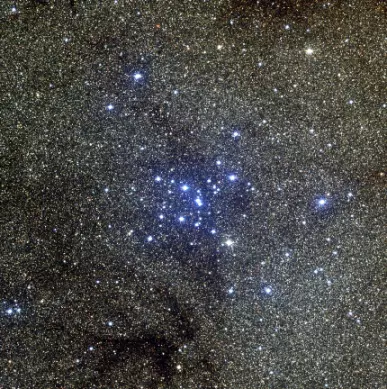
The Ptolemy Cluster (Messier 7), image: NASA
Messier’s list includes almost all the best examples of different types of deep sky objects – galaxies, open clusters, globular clusters, planetary nebulae, and diffuse nebulae – that can be observed from Europe. Most Messier objects are among the nearest examples of their class to Earth and can be seen in great detail with larger instruments. This makes them popular targets for study among professional astronomers as well.
Even though these objects are bright and large, their true nature was not yet known in Messier’s time. The French astronomer referred to the galaxies and globular clusters in his catalogue as nebulae.
Messier’s catalogue was first published in “Mémoires de l’Academie“, the journal of the French Academy of Sciences in Paris in 1774, and the final version came out in 1781, in Connaissance des temps for 1784, an official astronomical annual publication in France.
The original catalogue included 45 deep sky objects, and the 1781 version had 103.
Today’s versions of Messier’s catalogue contain 110 objects. They include objects that were observed by Messier and his colleague Pierre Méchain after the catalogue was published. The final seven Messier objects – M104 to M110 – were added by astronomers and historians between 1921 and 1966 after discovering evidence that the objects were observed either by Messier or Méchain.
Messier 104 was added by the French astronomer and author Nicolas Camille Flammarion in 1921, the objects M105 to M107 were added by the Canadian astronomer Helen Sawyer Hogg in 1947, M108 and M109 were added by the American astronomer Owen Gingerich in 1960, and the last one, M110, was added by the Welsh astronomer Kenneth Glyn Jones in 1967.
Almost all Messier objects are listed in the New General Catalogue of Nebulae and Clusters and Stars (NGC) and have NGC designations. The New General Catalogue was compiled by the Danish astronomer John Louis Emil Dreyer in 1888.
MESSIER OBJECTS MAP
MESSIER OBJECTS LIST
Messier 1 (M1) – Crab Nebula
Messier 1 (NGC 1952), popularly known as the Crab Nebula, is a supernova remnant in the Taurus constellation. It has an apparent magnitude of 8.4 and is approximately 6,500 light years distant. It has an apparent size of 420 by 290 arcseconds and a physical radius of 5.5 light-years.
M1 is associated with a historic supernova observed in 1054 CE. The remnant was discovered by English astronomer John Bevis in 1731. The remnant of the star that produced the supernova event was only discovered in 1968. It is a neutron star known as the Crab Pulsar or Baade’s Star.
The Crab Nebula appears near Tianguan (Zeta Tauri), the star that marks the southern horn of the celestial Bull.
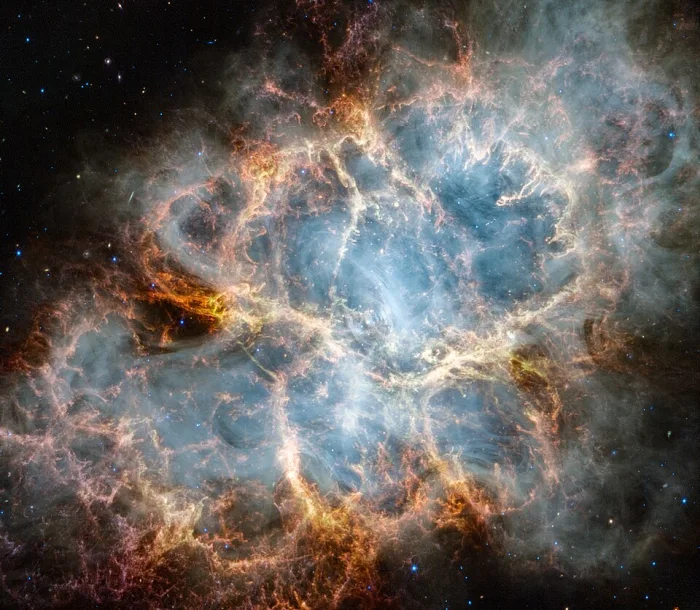
The NASA/ESA/CSA James Webb Space Telescope has gazed at the Crab Nebula in the search for answers about the supernova remnant’s origins. Webb’s NIRCam (Near-Infrared Camera) and MIRI (Mid-Infrared Instrument) have revealed new details in infrared light. Similar to the Hubble optical wavelength image released in 2005, with Webb the remnant appears to consist of a crisp, cage-like structure of fluffy red-orange filaments of gas that trace doubly ionised sulphur (sulphur III). Within the remnant’s interior, yellow-white and green fluffy ridges form large-scale loop-like structures, which represent areas where dust particles reside. The area is composed of translucent, milky material. This material is emitting synchrotron radiation, which is emitted across the electromagnetic spectrum but becomes particularly vibrant thanks to Webb’s sensitivity and spatial resolution. It is generated by particles accelerated to exceptionally high speeds as they wind around magnetic field lines. The synchrotron radiation can be traced throughout the majority of the Crab Nebula’s interior. Locate the wisps that follow a ripple-like pattern in the middle. In the centre of this ring-like structure is a bright white dot: a rapidly rotating neutron star. Further out from the core, follow the thin white ribbons of the radiation. The curvy wisps are closely grouped together, following different directions that mimic the structure of the pulsar’s magnetic field. Note how certain gas filaments are bluer in colour. These areas contain singly ionised iron (iron II). Image credit: NASA, ESA, CSA, STScI, T. Temim (Princeton University) (CC BY 4.0)
Messier 2 (M2)
Messier 2 (NGC 7089) is a globular cluster located 55,000 light-years from Earth in the constellation Aquarius. It has a visual magnitude of 6.5 and an apparent size of 16 arcminutes.
The star cluster has an estimated age of 12.5 billion years and stretches approximately 175 light-years across. It was discovered by the French astronomer Jean-Dominique Maraldi in 1746. It appears 5 degrees north of Sadalsuud (Beta Aquarii), the brightest star in Aquarius.
Messier 3 (M3)
Messier 3 (NGC 5272) is a globular cluster located 33,900 light-years away in the constellation Canes Venatici (the Hunting Dogs), near the border with Coma Berenices (Berenice’s Hair). It shines at magnitude 6.39 and has an apparent size of 18 arcminutes.
M3 was discovered by Charles Messier on May 3, 1764. The cluster has an estimated age of 11.39 billion years.
Messier 4 (M4) – Spider Globular Cluster
Messier 4 (NGC 6121) is a globular cluster located 6,033 light-years away in the zodiac constellation of Scorpius. It is the nearest globular cluster to the Sun. It has an apparent magnitude of 5.6 and an apparent size of 26 arcminutes. The cluster appears near the bright Antares in the sky.
M4 is also known as the Spider Globular Cluster. It has an estimated age of 12.2 billion years. It was discovered by the French astronomer Jean-Philippe Loys de Chéseaux in 1745.
Messier 5 (M5) – Rose Cluster
Messier 5 (NGC 5904) is a globular cluster in the Serpens constellation. It has a visual magnitude of 5.6 and is about 24,500 light years distant from Earth. It has an apparent size of 23 arcminutes and a linear radius of 80 light-years.
M5 is sometimes known as the Rose Cluster. It was discovered by the German astronomer Gottfried Kirch in 1702. It has an estimated age of 10.62 billion years.
Messier 6 (M6) – Butterfly Cluster
Messier 6 (NGC 6405) is an open star cluster located 1,590 light-years away in the constellation Scorpius. With an apparent magnitude of 4.2 and an apparent size of 25 arcminutes, it is visible to the unaided eye on a clear night.
M6 is also known as the Butterfly Cluster. It has an estimated age of 94.6 million years. About 120 stars in the cluster are brighter than magnitude 1.51. Most bright members are hot, blue B-type stars. The cluster has a radius of 6 light-years.
Italian astronomer Giovanni Battista Hodierna is usually credited for the discovery of M6. However, the cluster may have been observed by Claudius Ptolemy in the 2nd century CE while observing the nearby Messier 7.
Messier 7 (M7) – Ptolemy Cluster
Messier 7 (NGC 6475) is a bright open cluster located 980 light-years away in the constellation Scorpius. Like its neighbour Messier 6, it appears in the region between the Scorpion’s stinger and the Teapot asterism in Sagittarius.
The Ptolemy Cluster has an apparent magnitude of 3.3 and an apparent size of 80 arcminutes, corresponding to a physical radius of 25 light-years. It has a mass of 735 Suns and an estimated age of 200 million years.
M7 was named after the Greco-Roman astronomer Claudius Ptolemy, who was the first to record it in the 2nd century CE.

This image from the Wide Field Imager on the MPG/ESO 2.2-metre telescope at ESO’s La Silla Observatory in Chile, shows the bright star cluster Messier 7, also known as NGC 6475. Easily spotted by the unaided eye in the direction of the tail of the constellation of Scorpius (The Scorpion), this cluster is one of the most prominent open clusters of stars in the sky and an important research target. Credit: ESO (CC BY 3.0)
Messier 8 (M8) – Lagoon Nebula
Messier 8 (NGC 6523) is a large emission nebula located 4,100 light-years away in the constellation Sagittarius. It has an apparent magnitude of 4.6 and an apparent size of 90 by 40 arcminutes, corresponding to a physical diameter of 110 by 50 light-years.
The giant interstellar cloud contains an H II region, a stellar nursery associated with the young open cluster NGC 6530. The cluster has an estimated age of only 4 – 6 million years.
The Lagoon Nebula was discovered by Giovanni Battista Hodierna before 1654. It appears in the same region of the sky as the Trifid Nebula (Messier 20) and the open cluster Messier 21.
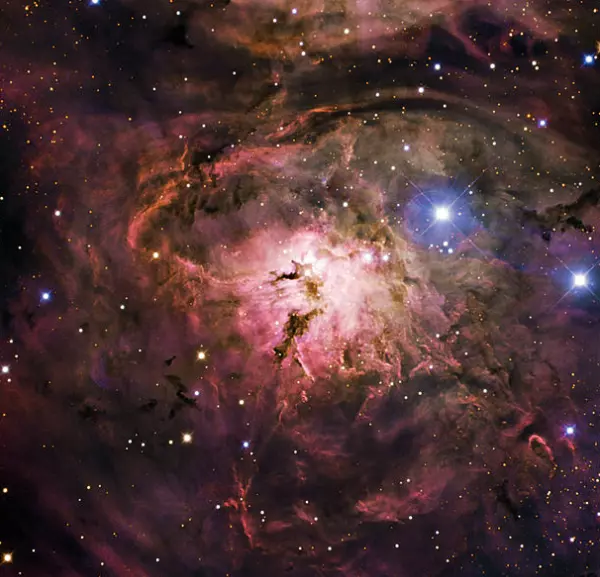
Lagoon Nebula (Messier 8), image: ESO/IDA/Danish 1.5 m/ R. Gendler, U.G. Jørgensen, K. Harpsøe (CC BY 4.0)
Messier 9 (M9)
Messier 9 (NGC 6333) is a globular cluster located approximately 25,800 light-years away in the constellation Ophiuchus. It has an apparent visual magnitude of 7.7 and an apparent size of 9.3 arcminutes, corresponding to a linear radius of 45 light-years. The cluster has a luminosity of 120,000 Suns.
M9 is believed to be around 12 billion years old. It appears southwest of Sabik (Eta Ophiuchi) in the sky. It was discovered by Charles Messier on June 3, 1764.
Messier 10 (M10)
Messier 10 (NGC 6254) is a globular cluster in Ophiuchus. It lies 14,300 light-years away and has an apparent magnitude of 6.6. It occupies 20 arcminutes of the apparent sky and has a physical radius of 41.6 light-years.
M10 has an estimated age of 11.39 billion years. It was discovered by Charles Messier on May 29, 1764. It appears in the central part of Ophiuchus, near another bright globular cluster, Messier 12.
Messier 11 (M11) – Wild Duck Cluster
Messier 11 (NGC 6705), popularly known as the Wild Duck Cluster, is an open star cluster located 6,120 light-years away in the constellation Scutum (the Shield). It is one of the richest, most massive and compact open clusters known.
The Wild Duck Cluster has an apparent magnitude of 5.8 and an apparent size of 22.8 arcminutes. It has a linear radius of 95 light-years and an estimated age of 316 million years. It was discovered by the German astronomer Gottfried Kirch in 1681.
Messier 12 (M12)
Messier 12 (NGC 6218) is a loosely packed globular cluster located 16,440 light-years away in the constellation Ophiuchus. It has an apparent magnitude of 6.7 and an apparent size of 16 arcminutes, corresponding to a spatial diameter of 75 light-years.
The cluster is thought to be around 13.8 billion years old. It was discovered by Charles Messier on May 30, 1764.
Messier 13 (M13) – Great Hercules Cluster
Messier 13 (NGC 6205) is a bright globular cluster located approximately 22,200 light-years away in the constellation Hercules. It appears in the region of the Keystone asterism. It has an apparent magnitude of 5.8 and an apparent size of 20 arcminutes.
The cluster is around 145 light-years in diameter and contains several hundred thousand stars. It is also known as the Great Hercules Cluster, the Hercules Globular Cluster, or the Great Globular Cluster in Hercules. It was discovered by the English astronomer Edmond Halley in 1714.
The cluster has an estimated age of 11.65 billion years.
Messier 14 (M14)
Messier 14 (NGC 6402) is a globular cluster located 30,300 light-years away in Ophiuchus. It has an apparent magnitude of 7.6 and an apparent size of 11 arcminutes, corresponding to a size about 100 light-years across.
The cluster was discovered by Charles Messier in 1764.
Messier 15 (M15) – Great Pegasus Cluster
Messier 15 (NGC 7078) is a globular cluster located in the constellation Pegasus. It shines at magnitude 6.2 from a distance of 35,690 light-years. It has an apparent size of 18 minutes of arc and a radius of around 88 light-years.
The Great Pegasus Cluster was discovered by the Italian astronomer Jean-Dominique Maraldi in 1746. It has an estimated age of 12.5 billion years.
Messier 16 (M16) – Eagle Nebula
Messier 16 (NGC 6611) is a young star cluster located in the constellation Serpens. It has an apparent magnitude of 6.4 and lies 5,700 light-years away. It has an apparent size of 70 by 50 arcminutes, corresponding to a spatial radius of 70 by 55 light-years.
The open cluster appears in the same region of the sky as the Lagoon and Trifid nebulae in Sagittarius. It is only 1-2 million years old. It contains around 8,100 stars.
M16 is also known as the Eagle Nebula or the Star Queen Nebula. It is part of a larger emission nebula catalogued as IC 4703.
The Eagle Nebula was discovered by the Swiss astronomer Jean-Philippe Loys de Chéseaux in 1745-46. It contains the famous Pillars of Creation region, trunks of gas and dust famously photographed by the Hubble Space Telescope in 1995.
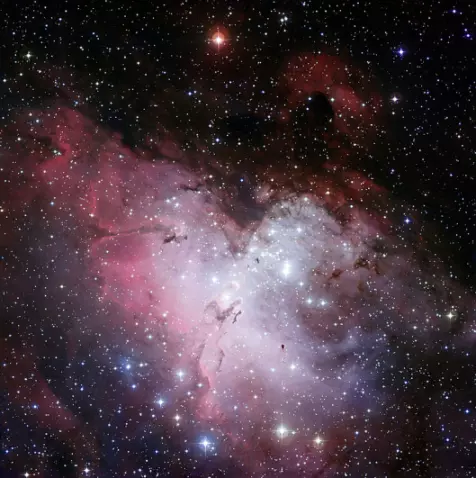
This is a three-colour composite mosaic image of the Eagle Nebula (Messier 16, or NGC 6611), based on images obtained with the Wide-Field Imager camera on the MPG/ESO 2.2-metre telescope at the La Silla Observatory. At the centre, the so-called “Pillars of Creation” can be seen. This wide-field image shows not only the central pillars, but also several others in the same star-forming region, as well as a huge number of stars in front of, in, or behind the Eagle Nebula. The cluster of bright stars to the upper right is NGC 6611, home to the massive and hot stars that illuminate the pillars. The “Spire” — another large pillar — is in the middle left of the image. Image: ESO (CC BY 4.0)
Messier 17 (M17) – Omega Nebula
Messier 17 (NGC 6618) is an H II region located 5,000 – 6,000 light-years away in the constellation Sagittarius. It has an apparent magnitude of 6.0 and an apparent size of 11 arcminutes. It is also known as the Omega Nebula, Swan Nebula, Horseshoe Nebula, Checkmark Nebula, and the Lobster Nebula.
The nebula is ionized by the intense radiation of the hot stars in the open cluster NGC 6618. It was discovered by Jean-Philippe Loys de Chéseaux in 1745. It appears near the open cluster Messier 18 in the sky.
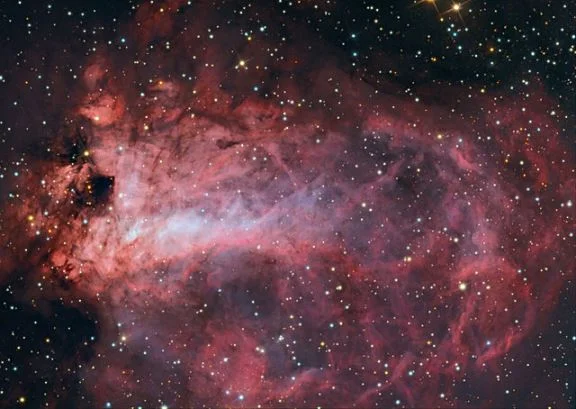
Omega Nebula (Messier 17), image: Adam Block/Mount Lemmon SkyCenter/University of Arizona (CC BY-SA 4.0)
Messier 18 (M18) – Black Swan Cluster
Messier 18 (NGC 6613) is an open cluster in Sagittarius. It has a visual magnitude of 7.5 and is approximately 4,230 light years distant. It is sometimes known as the Black Swan Cluster. It has an apparent size of 9.8 arcminutes, corresponding to a radius of 26.2 light-years.
M18 was discovered by Charles Messier in 1764. It has an estimated age of only 33 million years and a mass of 188 solar masses.
Messier 19 (M19)
Messier 19 (NGC 6273) is a globular cluster that lies 28,700 light-years away in Ophiuchus. With an apparent magnitude of 6.8 and an apparent size of 17 arcminutes, it can be observed in binoculars. The cluster has a radius of 70 light years and an estimated age of 11.90 billion years.
M19 was discovered by Charles Messier on June 5, 1764. It appears near the border with the constellation Scorpius, in the same area as the globular cluster Messier 62.
Messier 20 (M20) – Trifid Nebula
Messier 20 (NGC 6514) is an H II region located around 4,100 light-years away in Sagittarius. It appears next to the larger Lagoon Nebula (M8) in the sky. The star-forming nebula has an apparent magnitude of 6.3 and an apparent size of 28 arcminutes. It has a physical radius of 21 light-years.
M20 is also known as the Trifid Nebula. The name means “three-lobe” and refers to the nebula’s appearance. M20 is composed of an emission nebula, a reflection nebula, an open cluster, and a dark nebula.
The nebula was discovered by Charles Messier on June 5, 1764.
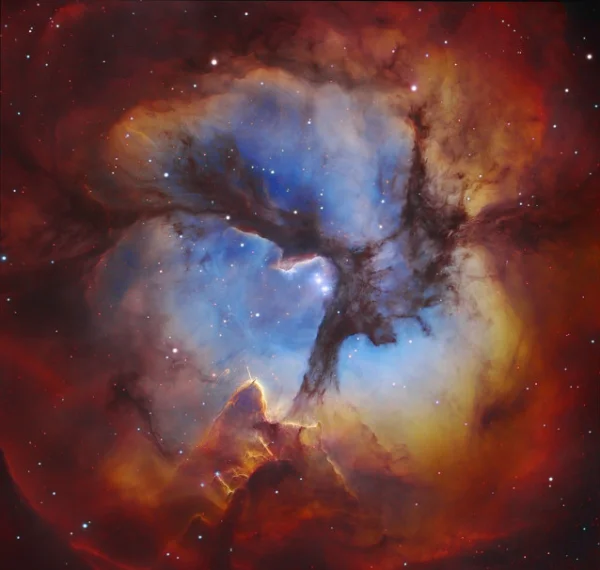
The central region of the Trifid Nebula (M20). Image: Subaru Telescope (NAOJ), Hubble Space Telescope, Martin Pugh; Processing: Robert Gendler (CC BY-SA 4.0)
Messier 21 (M21) – Webb’s Cross Cluster
Messier 21 (NGC 6531) is a young open star cluster located 3,930 light-years away in Sagittarius. It has an apparent magnitude of 6.5 and an apparent size of 14 arcminutes. It has a mass of 783.4 Suns and a radius of 12 light years. The cluster is believed to be only 6.6 million years old.
M21 was discovered by Charles Messier on June 5, 1764. It appears in the same area as the Lagoon and Trifid nebulae.
Messier 22 (M22) – Great Sagittarius Cluster
Messier 22 (NGC 6656) is an elliptical globular cluster that lies 10,600 light-years away in Sagittarius. The cluster appears just northeast of Kaus Borealis (Lambda Sagittarii), the star that marks the top of the celestial Teapot. It was discovered by German amateur astronomer Abraham Ihle in 1665.
The Great Sagittarius Cluster is about 99 light-years across and has an apparent size of 32 arcminutes. With an apparent magnitude of 5.1, it is the brightest globular cluster that can be seen from the mid-northern latitudes. It has an estimated age of 12 billion years.
Messier 23 (M23)
Messier 23 (NGC 6494) is an open star cluster in the northwestern part of the Sagittarius constellation. It has an apparent magnitude of 5.5 and an apparent size of 35 arcminutes. It was discovered by Charles Messier in 1764.
M23 lies 2,050 light-years away. It has a mass of 1,206 solar masses and a radius of 8 light-years. It is believed to be around 330 million years old.
Messier 24 (M24) – Small Sagittarius Star Cloud
Messier 24 (IC 4715) is a Milky Way star cloud located approximately 10,000 light-years away in the direction of the constellation Sagittarius. The Milky Way patch has an apparent magnitude of 2.5 and an apparent size of 2 by 1 degrees, making it one of the larger Messier objects by angular size.
M24 has a radius of around 300 light-years and a depth of 10,000 – 16,000 light-years. It appears near the Omega Nebula (M17) and the star cluster M18. It is one of the few Messier objects that are not real deep sky objects.
The Small Sagittarius Star Cloud was discovered by Charles Messier on June 20, 1764. It appears about 10 degrees north of the Large Sagittarius Star Cloud, which lies just north of Alnasl (Gamma2 Sagittarii).
Messier 25 (M25)
Messier 25 (IC 4725) is an open cluster located approximately 2,000 light-years away in the constellation Sagittarius. It has an apparent magnitude of 4.6 and an apparent size of 36 arcminutes. It is believed to be 67.6 million years old.
M25 was discovered by Jean-Philippe Loys de Chéseaux in 1745. The star cluster has a radius of 6.5 light-years and a mass of 1,937 Suns.
Messier 26 (M26)
Messier 26 (NGC 6694) is an open star cluster located 5,160 light-years from Earth in the constellation Scutum. It has an apparent magnitude of 8.0 and an apparent size of 14 arcminutes, corresponding to a physical radius of 11 light-years. It was discovered by Charles Messier in 1764.
M26 lies south-southwest of the better-known Wild Duck Cluster (M11). It has an estimated age of 85.3 million years.
Messier 27 (M27) – Dumbbell Nebula
Messier 27 (NGC 6853) is a planetary nebula located approximately 1,360 light-years away in the northern constellation Vulpecula (the Fox). With an apparent magnitude of 7.4, it is one of the brightest planetary nebulae in the sky. The nebula has an apparent size of 8 by 5.6 arcminutes and can be seen in binoculars. It has a radius of 1.44 light-years.
M27 is also known as the Dumbbell Nebula or the Apple Core Nebula. It was the first planetary nebula to be discovered. Charles Messier was the first to record it in 1764. The nebula appears roughly halfway between Albireo (Beta Cygni) at the Swan’s beak and the constellation figure of Delphinus.
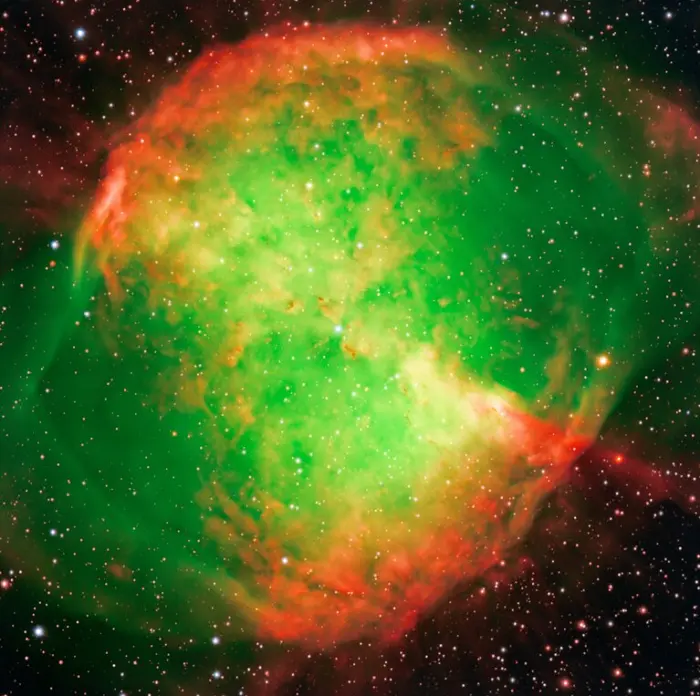
The Dumbbell Nebula — also known as Messier 27 or NGC 6853 — is a typical planetary nebula and is located in the constellation Vulpecula (The Fox). The distance is rather uncertain, but is believed to be around 1,200 light-years. It was first described by the French astronomer and comet hunter Charles Messier who found it in 1764 and included it as no. 27 in his famous list of extended sky objects. Despite its class, the Dumbbell Nebula has nothing to do with planets. It consists of very rarified gas that has been ejected from the hot central star (well visible on this photo), now in one of the last evolutionary stages. The gas atoms in the nebula are excited (heated) by the intense ultraviolet radiation from this star and emit strongly at specific wavelengths. Image credit: ESO/I. Appenzeller, W. Seifert, O. Stahl, M. Zamani (CC BY 4.0)
Messier 28 (M28)
Messier 28 (NGC 6626) is a globular cluster in Sagittarius. It shines at magnitude 6.8 from a distance of 18,260 light-years. It has an angular size of 11.2 arcminutes and a radius of 30 light-years.
The cluster appears less than a degree northwest of Kaus Borealis (Lambda Sagittarii), in the same area as the globular cluster Messier 22 (the Great Sagittarius Cluster). It was discovered by Charles Messier in 1764. It has an estimated age of 12 billion years.
Messier 29 (M29) – Cooling Tower Cluster
Messier 29 (NGC 6913) is a small open cluster located 5,240 light-years away in the northern constellation Cygnus (the Swan). The cluster appears 1.7 degrees south of Sadr (Gamma Cygni), the central star of the Northern Cross. It has an apparent magnitude of 7.1 and an angular size of 7 arcminutes, corresponding to a physical radius of 11 light-years.
Charles Messier discovered M29 in 1764. The cluster is composed of very young stars. It has an estimated age of only 13.2 million years.
Messier 30 (M30) – Jellyfish Cluster
Messier 30 (NGC 7099) is a globular cluster that lies 27,140 light years away in the zodiac constellation of Capricornus. It has an apparent visual magnitude of 7.2 and an apparent size of 12 arcminutes. It is believed to be 12.92 billion years old.
M30 was discovered by Charles Messier in 1764. Messier described the cluster as a circular nebula without a star.
Messier 31 (M31) – Andromeda Galaxy
Messier 31 (NGC 224) is a barred spiral galaxy located 2.50 million light-years away in the constellation Andromeda. With an apparent magnitude of 3.44 and an apparent size of 3.167 by 1 degrees, the galaxy is visible to the unaided eye on a very clear, dark night. It has been known to observers since ancient times.
The Andromeda Galaxy is the largest member of the Local Group of galaxies, which also includes the Triangulum Galaxy (M33) and the Milky Way. It has a diameter of 152,000 light-years and is the nearest large galaxy to the Milky Way.
Andromeda is expected to collide with the Milky Way in about 4-5 billion years and the two galaxies will eventually merge to form a large lenticular or giant elliptical galaxy.
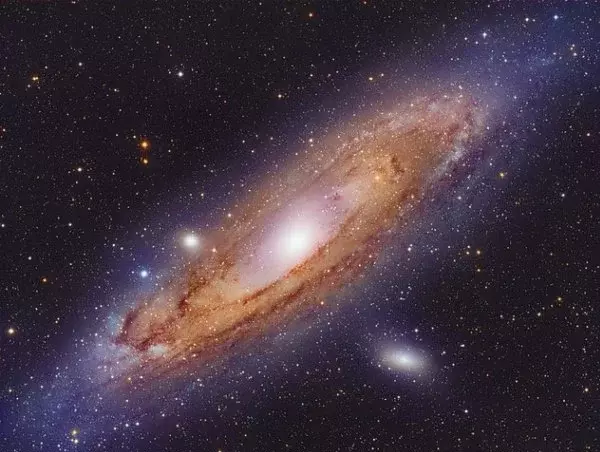
Andromeda Galaxy (Messier 31), image: Ivan Bok (CC BY 4.0)
Messier 32 (M32)
Messier 32 (NGC 221) is a dwarf elliptical galaxy located 2.49 million light-years away in the constellation Andromeda. It is a satellite galaxy of the larger Andromeda Galaxy. It was discovered by the French astronomer Guillaume de Gentil in 1749.
M32 has an apparent magnitude of 8.08 and an apparent size of 8.7 by 6.5 arcminutes. It contains mostly old yellow and red stars and does not show signs of current star formation. The galaxy hosts a supermassive black hole with a mass between 1.5 and 5 million solar masses.
Messier 33 (M33) – Triangulum Galaxy
Messier 33 (NGC 598) is a spiral galaxy located 2.73 million light-years away in the constellation Triangulum. Like the brighter and larger Andromeda Galaxy, the Triangulum Galaxy is a member of the Local Group. The Andromeda and Triangulum galaxies are the most distant objects visible to the unaided eye, but both require exceptionally good conditions to be seen.
The Triangulum Galaxy is the third largest galaxy in the Local Group, after Andromeda and the Milky Way. M33 is around 70% the size of the Milky Way.
The galaxy has an apparent magnitude of 5.72 and an apparent size of 70.8 by 41.7 arcminutes. It was discovered by the Italian astronomer Giovanni Battista Hodierna before 1654.
Messier 34 (M34) – Spiral Cluster
Messier 34 (NGC 1039) is an open star cluster located 1,500 light-years away in the constellation Perseus. It appears in the region between Algol in Perseus and Almach in the neighbouring Andromeda. It has an estimated age of 200 – 250 million years.
The Spiral Cluster has an apparent magnitude of 5.5 and an angular size of 35 arcminutes, corresponding to a radius of 7 light-years. It was discovered by Giovanni Batista Hodierna before 1654.
Messier 35 (M35) – Shoe-Buckle Cluster
Messier 35 (NGC 2168) is a bright, large open cluster located 2,970 light-years away in the constellation Gemini. It appears near Tejat and Propus, the stars that mark Castor’s foot. The open cluster NGC 2158 appears in the same wide field of view as M35.
The Shoe-Buckle Cluster has an apparent visual magnitude of 5.3 and an apparent size of 28 arcminutes. It has a physical radius of 11 light-years and a mass of 1,600 Suns. It was discovered by Jean-Philippe Loys de Chéseaux around 1745. The cluster has an estimated age of 100 million years.
Messier 36 (M36) – Pinwheel Cluster
Messier 36 (NGC 1960) is an open cluster located 4,340 light-years away in the constellation Auriga (the Charioteer). With an apparent magnitude of 6.3 and an apparent size of 12 arcminutes, it can be spotted in binoculars. It was discovered by Giovanni Batista Hodierna before 1654.
The Pinwheel Cluster has a mass of around 746 solar masses and a radius of 7 light-years. Like M37 and M38, it appears in the region of Auriga’s hexagon. It has an estimated age of only 25.1 million years.
Messier 37 (M37) – Salt and Pepper Cluster
Messier 37 (NGC 2099) is an open star cluster in Auriga. It shines at magnitude 6.2 from a distance of 4,511 light-years. It has an angular size of 24 arcminutes.
Popularly known as the Salt and Pepper Cluster, M37 has a mass of 1,500 Suns and contains more than 500 known members within a diameter of 20 – 25 light-years. It was discovered by Giovanni Batista Hodierna before 1654.
Messier 38 (M38) – Starfish Cluster
Messier 38 (NGC 1912) is an open cluster located 3,480 light-years away in Auriga. It has an apparent magnitude of 7.4 and an apparent size of 21 arcminutes. It was discovered by Giovanni Batista Hodierna before 1654. The cluster is around 26 light-years across and has an estimated age of 250 million years.
Messier 39 (M39) – Pyramid Cluster
Messier 39 (NGC 7092) is an open cluster located 1,010 light-years away in the constellation Cygnus. It appears 2 degrees south of the star Azelfafage (Pi Cygni). It is sometimes known as the Pyramid Cluster.
The cluster shines at magnitude 4.6 and has an angular size of 29 arcminutes. It has an estimated age of 278.6 million years. It was discovered by Guillaume Le Gentil in 1749.
Messier 40 (M40)
Messier 40 (Winnecke 4) is a visual double star in the constellation Ursa Major (the Great Bear). It was catalogued by Charles Messier by mistake. The French astronomer discovered the visual pair in 1764 while searching for a nebula.
The optical pair consists of an orange giant located 1,013 light-years away and a yellow dwarf 470 light-years away. The two stars are not physically related. The orange giant has an apparent magnitude of 9.64 and the dwarf star shines at magnitude 10.11. Neither star is visible to the unaided eye.
M40 lies in the same area of the sky as Megrez (Delta Ursae Majoris), the faintest of the seven Big Dipper stars. The optical double was rediscovered by the German astronomer Friedrich August Theodor Winnecke in 1863 and listed in the Winnecke Catalogue of Double Stars as Winnecke 4.
Messier 41 (M41) – Little Beehive Cluster
Messier 41 (NGC 2287) is a bright open cluster located 2,360 light-years away in the constellation Canis Major. It has an apparent size of 38 arcminutes – comparable to the size of the full Moon – and a radius of 12.5 light-years.
The cluster is estimated to be 200 million years old. It has been nicknamed the Little Beehive Cluster because of its resemblance to the brighter and larger Beehive Cluster (M44).
The Little Beehive Cluster was discovered by Giovanni Batista Hodierna before 1654 but may have been spotted by Greek philosopher Aristotle in 325 BCE. It appears around four degrees south of Sirius, the brightest star in the sky.
Messier 42 (M42) – Orion Nebula
Messier 42 (NGC 1976) is a diffuse nebula located 1,344 light-years away in the constellation Orion (the Hunter). The stellar nursery appears as the central point of light in Orion’s Sword. It is the nearest region of massive star formation to the Sun.
With an apparent magnitude of 4.0 and an apparent size of 65 by 60 arcminutes, the Orion Nebula is visible to the unaided eye from areas without too much light pollution. It is about 25 light-years across. It has been known to observers since antiquity.
The young Trapezium Cluster lies at the centre of the nebula. The four brightest stars in the cluster form a trapezium shape and lie in an area with a diameter of only 1.5 light years. The cluster is part of the larger Orion Nebula cluster, which contains around 2,800 hot young stars.
The Orion Nebula is part of the Orion molecular cloud complex, a larger star forming region that also includes De Mairan’s Nebula (M43) and the reflection nebula Messier 78.
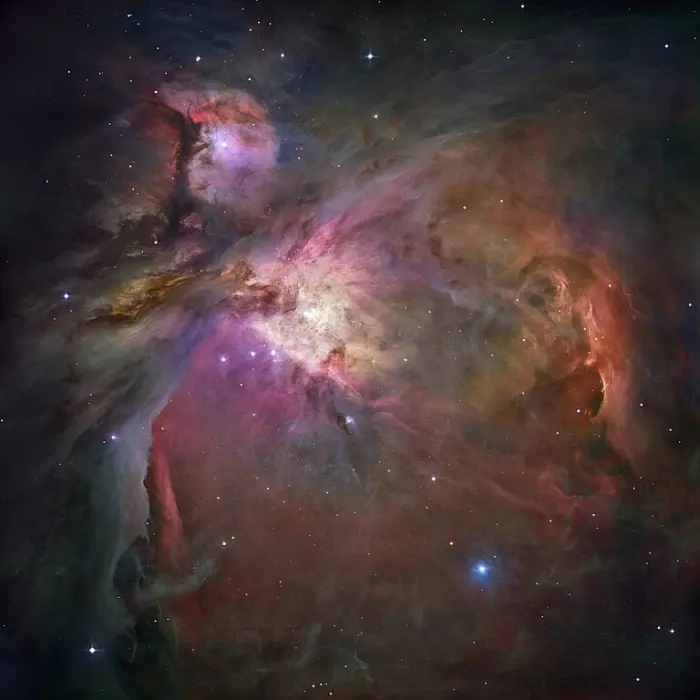
The Orion Nebula (M42) by the Hubble Space Telescope, credit: NASA, ESA, M. Robberto (Space Telescope Science Institute/ESA) and the Hubble Space Telescope Orion Treasury Project Team (PD)
Messier 43 (M43) – De Mairan’s Nebula
Messier 43 (NGC 1982) is a stellar nursery located approximately 1,300 light-years away in Orion’s Sword. The H II region is part of the Orion Nebula, but appears separated from M42 by a dark, dense dust lane. It has an apparent magnitude of 9.0 and an apparent size of 20 by 15 arcminutes.
De Mairan’s Nebula is named after the French natural philosopher Jean-Jacques d’Ortous de Mairan, who discovered it before 1731. The nebula is ionized the hot young triple star system Nu Orionis.
Messier 44 (M44) – Beehive Cluster (Praesepe)
Messier 44 (NGC 2632) is a young open cluster located only 610 light-years away in the Cancer constellation. With an apparent magnitude of 3.7 and an apparent size of 95 arcminutes, the cluster is easily visible to the unaided eye and outshines the rest of the host constellation. It appears roughly halfway between the bright Pollux in Gemini and Regulus in Leo. It is also known as Praesepe or the Beehive Cluster.
Like the Pleiades and the Hyades, M44 has been known since ancient times due to its brightness and size. Italian astronomer Galileo Galilei was the first to resolve individual stars in the cluster.
The Beehive Cluster has a mass of 500 – 600 solar masses and an estimated age of 600 – 700 million years.
Messier 45 (M45) – Pleiades
Messier 45, better known as the Pleiades or Seven Sisters, is an open star cluster located only 444 light-years away in the Taurus constellation. It is one of the brightest, largest and nearest open clusters to the Sun, along with the Hyades.
With an apparent visual magnitude of 1.6 and an angular size of 2 degrees, the cluster stands out in the sky, even from areas with some light-pollution. It marks the shoulder of the celestial Bull. Its brightest stars are named after the mythical Pleiades sisters and their parents Pleione and Atlas in Greek mythology.
M45 has an estimated age of 75 to 150 million years and contains more than a thousand confirmed member stars. It packs a mass of 800 Suns into an area around 43 light-years across.
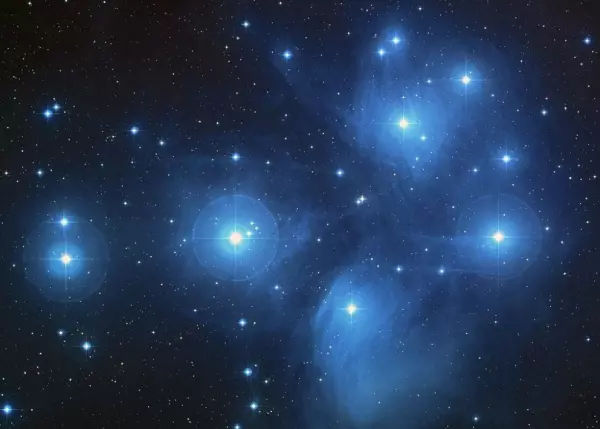
The Pleiades is an open cluster consisting of approximately 3,000 stars at a distance of 400 light-years (120 parsecs) from Earth in the constellation Taurus. (It also known as “The Seven Sisters”, or the astronomical designations NGC 1432/35 and M45.) Image: NASA, ESA, AURA, Caltech, Palomar Observatory (PD)
Messier 46 (M46)
Messier 46 (NGC 2437) is an open cluster located 4,920 light-years away in the constellation Puppis (the Stern). It contains around 500 stars and has a mass of 453 solar masses. With an apparent magnitude of 6.0 and an angular size of 22.8 arcminutes, it can be seen in binoculars.
The cluster has an estimated age of 251.2 million years. It was discovered by Messier himself on February 19, 1771. It appears close to the open cluster Messier 47 in the sky.
The planetary nebula NGC 2438 appears superimposed on M46 but is not related to the cluster. It lies 1,370 light years away and is much closer to us than M46.
Messier 47 (M47)
Messier 47 (NGC 2422) is an open cluster in Puppis. It has an apparent magnitude of 4.4 and is about 1,600 light years distant. It has an apparent size of 30 arcminutes and a physical radius of around 35 light years.
M47 was discovered by Giovanni Batista Hodierna before 1654. It appears only a degree from the fainter and more distant M46. It has an estimated age of 78 million years.
Messier 48 (M48)
Messier 48 (NGC 2548) is an open cluster located in the constellation Hydra (the Water Snake). It has a visual magnitude of 5.8 and is approximately 2,500 light years distant. It has an angular size of 30 arcminutes, corresponding to a linear radius of 63 light-years.
M48 was discovered by Charles Messier on February 19, 1771. It has an estimated age of around 450 million years.
Messier 49 (M49)
Messier 49 (NGC 4472) is a giant elliptical galaxy located approximately 55.9 million light years away in the constellation Virgo. It has an apparent size of 10.2 by 8.3 minutes of arc and an apparent visual magnitude of 8.4.
M49 was the first galaxy in the Virgo Cluster to be discovered. It is the brightest galaxy in the cluster. It has a diameter of 156,000 light-years. Charles Messier discovered it on February 19, 1771.
Messier 50 (M50) – Heart-Shaped Cluster
Messier 50 (NGC 2323) is an open star cluster in the constellation Monoceros (the Unicorn). It shines at magnitude 5.9 from a distance of 2,870 light-years. It has an angular size of 16 arcminutes and a radius of 8.9 light-years.
M50 is believed to be around 158 million years old. It appears in the same area as the Seagull Nebula (IC 2177), about a third of the way from Sirius in Canis Major to Procyon in Canis Minor.
The cluster was discovered by the Italian astronomer Giovanni Domenico Cassini before 1711. It contains more than 500 stars with a combined mass of over 285 solar masses.
In 2025, M50 was discovered to be a binary cluster. It consists of two distinct sub-clusters, NGC 2323-a and NGC 2323-b, that are gravitationally bound.
Messier 51 (M51) – Whirlpool Galaxy
Messier 51 (NGC 5194, NGC 5195) is an interacting grand-design spiral galaxy located around 31 million light-years away in the constellation Canes Venatici (the Hunting Dogs). The galaxy has an apparent magnitude of 8.4 and an apparent size of 11.2 by 6.9 arcminutes, corresponding to a physical diameter of 76,900 light-years. It is also known as the Question Mark Galaxy and Rosse’s Galaxy.
The Whirlpool Galaxy (M51a) has an active galactic nucleus (AGN). It is the brightest member of the M51 Group, which also includes the Sunflower Galaxy (M63). Messier 51a is interacting with a smaller neighbour, the dwarf galaxy Messier 51b (NGC 5195).
M51a was discovered by Charles Messier on October 13, 1773, and M51b by Pierre Méchain on March 21, 1781.
The interacting pair appears 3.5 degrees southwest of Alkaid (Eta Ursae Majoris), the star at the tip of the Great Bear’s tail.
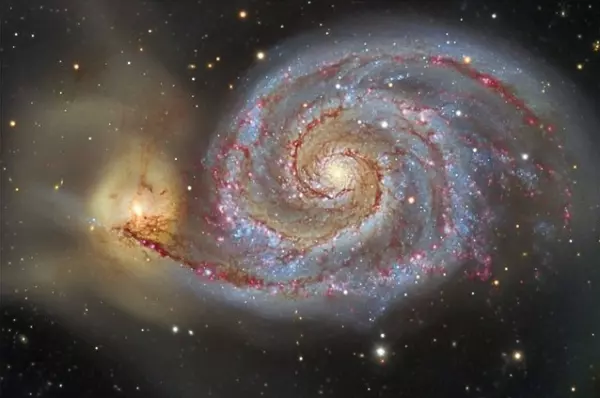
Whirlpool Galaxy (M51), image: Giuseppe Donatiello (CC0 1.0)
Messier 52 (M52) – Scorpion Cluster
Messier 52 (NGC 7654) is an open cluster located 4,600 light-years away in the Cassiopeia constellation. It has an apparent visual magnitude of 7.3 and an apparent size of 13 arcminutes. It appears in the same region as the Bubble Nebula (NGC 7635).
The star cluster was discovered by Charles Messier on September 7, 1774. It has an estimated age of 158.5 million years and a mass of 1,200 Suns.
Messier 53 (M53)
Messier 53 (NGC 5024) is a globular star cluster located around 58,000 light-years away in the constellation Coma Berenices. It has an apparent magnitude of 7.6 and an apparent size of 13 arcminutes.
The cluster was discovered by the German astronomer Johann Elert Bode on February 3, 1775. It has an estimated age of 12.67 billion years.
Messier 54 (M54)
Messier 54 (NGC 6715) is a globular cluster located 87,400 light-years away in the constellation Sagittarius. It was discovered by Charles Messier on July 24, 1778. It appears close to Ascella (Zeta Sagittarii), one of the stars that form the Teapot asterism.
M54 has an apparent visual magnitude of 7.6 and an apparent size of 12 arcminutes, corresponding to a linear radius of 153 light-years. It has an estimated age of 13 billion years. An intermediate-mass black hole was detected in the core of the cluster in 2009.
M54 is believed to belong not to the Milky Way but to a Milky Way satellite, the Sagittarius Dwarf Elliptical Galaxy (SagDEG).
Messier 55 (M55) – Specter Cluster
Messier 55 (NGC 6809) is a globular cluster that lies 17,600 light-years away in Sagittarius. It has an apparent magnitude of 6.3 and an angular size of 19 arcminutes. It has a physical radius of 48 light-years and is believed to be around 12.3 billion years old.
M55 was discovered by the French astronomer Nicolas-Louis de Lacaille in 1752.
Messier 56 (M56)
Messier 56 (NGC 6779) is a globular cluster approximately 32,900 light-years away in the northern constellation of Lyra. It has an apparent magnitude of 8.3 and an apparent size of 8.9 arcminutes. It appears almost halfway between Albireo in Cygnus and Sulafat in Lyra.
M56 was discovered by Messier himself on January 23, 1779. The cluster is about 84 light-years across and has an estimated age of 13.70 billion years. It is believed to be part of the Gaia Enceladus (Gaia Sausage), the remains of a dwarf galaxy that merged with the larger Milky Way some 8 – 11 billion years ago.
Messier 57 (M57) – Ring Nebula
Messier 57 (NGC 6720) is a planetary nebula located around 2,567 light-years away in the Lyra constellation. It is one of only four planetary nebulae listed in the Messier catalogue.
The Ring Nebula has an apparent size of 230 arcseconds and an apparent magnitude of 8.8. It has a physical radius of about 1.3 light-years. It was discovered by Charles Messier on January 31, 1779.
The nebula is very easy to find because it appears roughly halfway between Sheliak (Beta Lyrae) and Sulafat (Gamma Lyrae). These are two of the four relatively bright stars that form the parallelogram pattern that dominates the constellation Lyra.
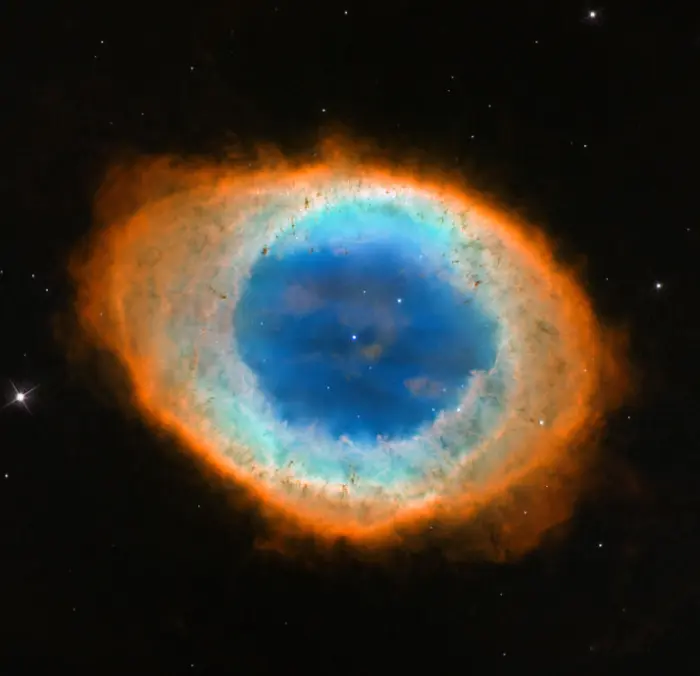
Ring Nebula captured by the Hubble Space Telescope, image credit: NASA, ESA, and C. Robert O’Dell (Vanderbilt University) (CC BY 3.0)
Messier 58 (M58)
Messier 58 (NGC 4579) is an intermediate barred spiral galaxy located 68 million light-years away in the Virgo constellation. With an apparent magnitude of 9.7 and an angular size of 5.9 by 4.7 arcminutes, the galaxy is one of the brightest members of the Virgo Cluster. It was discovered by Charles Messier on April 15, 1779, along with the elliptical galaxies Messier 59 and Messier 60.
M58 is about 133,000 light-years across. It has a supermassive black hole with a mass of 70 million Suns. It is one of the few examples of galaxies with an ultra-compact nuclear ring (UCNR), a ring of star-forming regions around the galactic core.
Messier 59 (M59)
Messier 59 (NGC 4621) is an elliptical galaxy that lies approximately 50.1 million light-years away in the constellation Virgo. It has an apparent magnitude of 9.6 and an apparent size of 5.4 by 3.7 arcminutes. It was discovered by German astronomer Johann Gottfried Koehler on April 11, 1779.
M59 is a member of the Virgo Cluster. It contains a supermassive black hole with an estimated mass of 270 million solar masses.
Messier 60 (M60)
Messier 60 (NGC 4649) is an elliptical galaxy located 56.7 million light-years away in the Virgo Cluster. It was discovered by Johann Gottfried Koehler on April 11, 1779, along with Messier 59. It has an apparent magnitude of 8.8 and an angular size of 7.4 by 6.0 arcminutes.
M60 forms a pair with the intermediate spiral galaxy NGC 4647. The galaxies are listed as Arp 116 in Halton Arp’s Atlas of Peculiar Galaxies.
Messier 61 (M61) – Swelling Spiral Galaxy
Messier 61 (NGC 4303) is an intermediate barred spiral galaxy located in the Virgo Cluster. The galaxy lies 52.5 million light years away and has an apparent magnitude of 9.7. It was discovered by the Italian astronomer Barnaba Oriani on May 5, 1779. Messier discovered the galaxy independently six days later and included it in his catalogue.
The Swelling Spiral Galaxy is a member of the M61 Group within the larger Virgo II Groups of galaxies in the southern part of the Virgo Supercluster. The galaxy is part of a Virgo Cluster subgroup known as the S Cloud. It hosted eight observed supernovae in the past century.
Messier 62 (M62) – Flickering Globular Cluster
Messier 62 (NGC 6266) is a globular cluster located 21,500 light-years away in the constellation Ophiuchus. It appears in the southern part of the celestial Serpent Bearer, on the border with Scorpius. Charles Messier discovered it on June 7, 1771.
M62 is one of the ten most massive and luminous globular clusters in the Milky Way. It has an estimated mass of 1.22 million solar masses and an absolute magnitude of -9.18.
With an apparent magnitude of 6.5 and an apparent size of 15 arcminutes, the cluster can be observed in small telescopes. It has an estimated age of 11.78 billion years.
Messier 63 (M63) – Sunflower Galaxy
Messier 63 (NGC 5055) is a spiral galaxy that lies 29.3 million light years away in the constellation Canes Venatici (the Hunting Dogs). It has an apparent magnitude of 9.3 and an apparent size of 12.6 by 7.2 arcminutes. It was discovered by the French astronomer Pierre Méchain on June 14, 1779.
Like the Whirlpool Galaxy (M51), the Sunflower Galaxy appears in the region between Cor Caroli (Alpha2 Canum Venaticorum) and Alkaid (Eta Ursae Majoris). It is a member of the M51 Group.
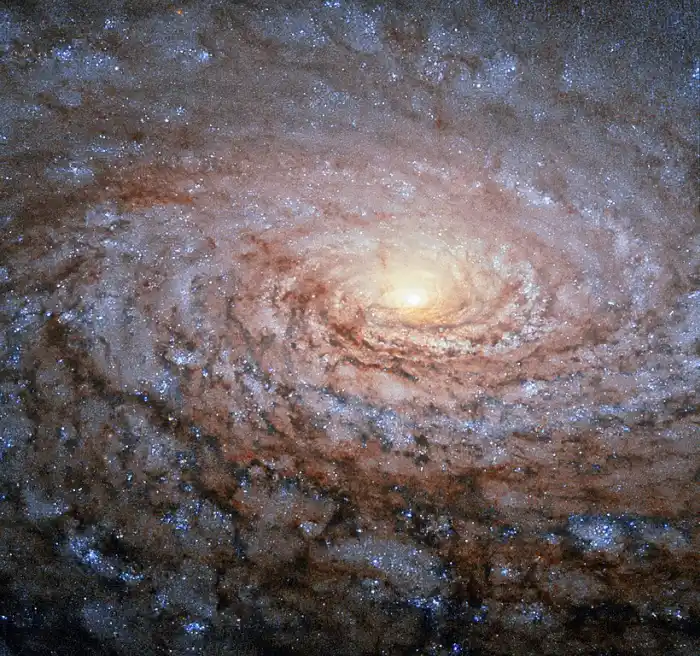
The arrangement of the spiral arms in the galaxy Messier 63, seen here in a new image from the NASA/ESA Hubble Space Telescope, recall the pattern at the centre of a sunflower. So the nickname for this cosmic object — the Sunflower Galaxy — is no coincidence. Discovered by Pierre Mechain in 1779, the galaxy later made it as the 63rd entry into fellow French astronomer Charles Messier’s famous catalogue, published in 1781. The two astronomers spotted the Sunflower Galaxy’s glow in the small, northern constellation Canes Venatici (the Hunting Dogs). We now know this galaxy is about 27 million light-years away and belongs to the M51 Group — a group of galaxies, named after its brightest member, Messier 51, another spiral-shaped galaxy dubbed the Whirlpool Galaxy. Galactic arms, sunflowers and whirlpools are only a few examples of nature’s apparent preference for spirals. For galaxies like Messier 63 the winding arms shine bright because of the presence of recently formed, blue–white giant stars, readily seen in this Hubble image. Image credit: ESA/Hubble & NASA (CC BY 4.0)
Messier 64 (M64) – Black Eye Galaxy
Messier 64 (NGC 4826) is a spiral galaxy located 17.3 million light-years away in the constellation Coma Berenices. It has an apparent magnitude of 8.52 and an apparent size of 10.71 by 5.128 arcminutes. It is classified as a type 2 Seyfert galaxy with an HII/LINER nucleus.
The Black Eye Galaxy is 53,800 light-years across. It is home to around 100 billion stars and has a supermassive black hole with a mass of 8.4 million solar masses at its centre.
M64 is also known as the Sleeping Beauty Galaxy or Evil Eye Galaxy. It was discovered by the English astronomer Edward Pigott on March 23, 1779. Charles Messier discovered the galaxy independently on March 1, 1780, and added it to his catalogue.
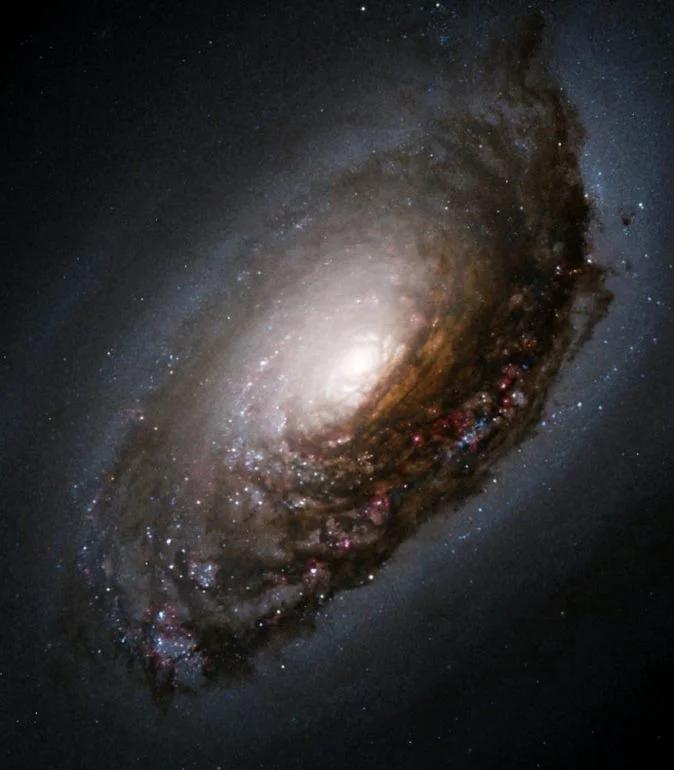
This image of Messier 64 (M64) was taken with Hubble’s Wide Field Planetary Camera 2 (WFPC2). The color image is a composite prepared by the Hubble Heritage Team from pictures taken through four different color filters. These filters isolate blue and near-infrared light, along with red light emitted by hydrogen atoms and green light from Strömgren y. M64 has a spectacular dark band of absorbing dust in front of the galaxy’s bright nucleus, giving rise to its nicknames of the Black Eye or Evil Eye galaxy. At first glance, M64 appears to be a fairly normal pinwheel-shaped spiral galaxy. As in the majority of galaxies, all of the stars in M64 are rotating in the same direction, clockwise as seen in the Hubble image. However, detailed studies in the 1990’s led to the remarkable discovery that the interstellar gas in the outer regions of M64 rotates in the opposite direction from the gas and stars in the inner regions. Active formation of new stars is occurring in the shear region where the oppositely rotating gases collide, are compressed, and contract. Particularly noticeable in the image are hot, blue young stars that have just formed, along with pink clouds of glowing hydrogen gas that fluoresce when exposed to ultraviolet light from newly formed stars. Astronomers believe that the oppositely rotating gas arose when M64 absorbed a satellite galaxy that collided with it, perhaps more than one billion years ago. This small galaxy has now been almost completely destroyed, but signs of the collision persist in the backward motion of gas at the outer edge of M64. Image: NASA and The Hubble Heritage Team (AURA/STScI) (CC BY 4.0)
Messier 65 (M65) – Leo Triplet
Messier 65 (NGC 3623) is an intermediate spiral galaxy located 41-42 million light-years away in the constellation Leo. It forms the Leo Triplet with Messier 66 and NGC 3628 (the Hamburger Galaxy or Sarah’s Galaxy). The galaxy was discovered by Charles Messier on March 1, 1780, along with M66, while NGC 3628 was discovered by William Herschel four years later.
M65 has an apparent magnitude of 9.3 and an angular size of 8.709 by 2.454 arcminutes.
The galaxies in the Leo Triplet appear roughly halfway between Chertan (Theta Leonis) and Iota Leonis, along the imaginary line connecting Denebola (Beta Leonis) and Regulus (Alpha Leonis).
Messier 66 (M66) – Leo Triplet
Messier 66 (NGC 3627) is an intermediate spiral galaxy located 31 million light-years away in the Leo constellation. It has an apparent magnitude of 8.9 and an angular size of 9.1 by 4.2 arcminutes. The galaxy has hosted five supernovae since 1973.
Messier 67 (M67) – Golden Eye Cluster (King Cobra Cluster)
Messier 67 (NGC 2682) is an open cluster located at a distance between 2,610 and 2,930 light-years from Earth in the constellation Cancer. It has an apparent magnitude of 6.1 and an apparent size of 30 arcminutes, corresponding to a radius of about 10 light-years.
The cluster was discovered by the German astronomer Johann Gottfried Koehler in 1779. It contains over 500 stars and has an estimated age between 3.2 and 5 billion years.
Messier 68 (M68)
Messier 68 (NGC 4590) is a globular cluster lying 33,600 light-years from Earth in the Hydra constellation. It has an apparent visual magnitude of 7.8 and an angular size of 11 arcminutes, corresponding to a linear radius of 53.5 light-years. It was discovered by Charles Messier on April 9, 1780.
The cluster has an estimated age of 11.2 billion years. It can be found using the stars of the Sail (Spica’s Spanker) asterism in Corvus. A line drawn from Algorab (Delta Corvi) through Kraz (Beta Corvi) leads to the cluster.
Messier 69 (M69)
Messier 69 (NGC 6637) is a globular star cluster located at a distance of 29,000 light-years in the Sagittarius constellation. With an apparent magnitude of 7.6 and an apparent size of 10.8 arcminutes, it can be seen in binoculars and observed in small and medium telescopes. The cluster was discovered by Charles Messier on August 31, 1780.
M69 has a radius of 45 light-years and a tidal radius of 91.9 light-years. It is believed to be 13.6 billion years old. It appears 2.5 degrees northeast of Kaus Australis (Epsilon Sagittarii), the brightest star in Sagittarius, in the same region as Messier 70.
Messier 70 (M70)
Messier 70 (NGC 6681) is a globular cluster located in the constellation Sagittarius. It shines at magnitude 7.9 from a distance of 29,400 light-years. It has an apparent size of 8 arcminutes, corresponding to a physical radius of 34 light-years.
M70 is believed to be around 12.80 billion years old. It was discovered by Messier on August 31, 1780, along with Messier 69.
Messier 71 (M71) – Angelfish Cluster
Messier 71 (NGC 6838) is a loosely concentrated globular cluster located approximately 13,000 light-years away in the northern constellation Sagitta (the Arrow). It has an apparent magnitude of 8.2 and an apparent size of 7.2 arcminutes, corresponding to a physical diameter of 27 light years. The cluster is believed to be 9 – 10 billion years old.
M71 appears in the region between Gamma and Delta Sagittae. The cluster was discovered by Philippe Loys de Chéseaux in 1745.
Messier 72 (M72)
Messier 72 (NGC 6981) is a globular star cluster located 54,570 light-years away in the zodiac constellation Aquarius. It has an apparent magnitude of 9.3 and an apparent size of 6.6 arcminutes.
M72 has an estimated age of 9.5 billion years. It was discovered by Pierre Méchain on August 30, 1780. It appears near Albali (Epsilon Aquarii).
Messier 73 (M73)
Messier 73 (NGC 6994) is an asterism consisting of four stars in the constellation Aquarius. It was previously believed to be an open star cluster. All four stars are over 1,000 light-years away and they are not physically related.
M73 appears a few arcminutes east of Messier 72. It was discovered by Charles Messier on October 4, 1780.
Messier 74 (M74) – Phantom Galaxy
Messier 74 (NGC 628) is a grand design spiral galaxy located 32 million light-years from Earth in the constellation Pisces. It has an apparent magnitude of 9.4 and an apparent size of 10.5 by 9.5 arcminutes. The galaxy is home to around 100 billion stars. It is 95,000 light-years across.
The Phantom Galaxy is the brightest member of the M74 Group, a group of galaxies that also includes the polar ring galaxy NGC 660 and several irregular galaxies.
M74 was discovered by Pierre Méchain in late September of 1780. It appears only 1.5 degrees from Alpherg (Eta Piscium) in the sky.
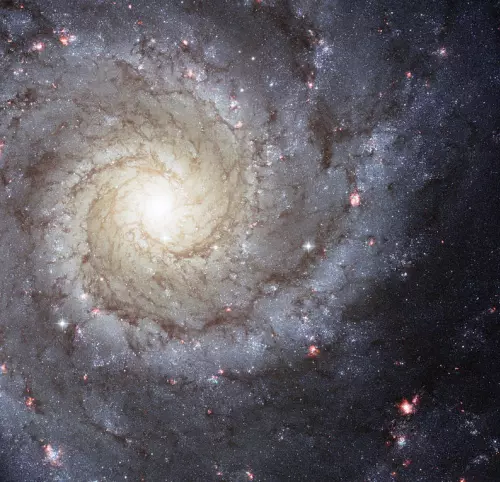
The grand-design spiral galaxy Messier 74 as photographed by the Hubble Space Telescope. Image: NASA, ESA, and the Hubble Heritage (STScI/AURA)-ESA/Hubble Collaboration. Acknowledgment: R. Chandar (University of Toledo) and J. Miller (University of Michigan) (PD)
Messier 75 (M75)
Messier 75 (NGC 6864) is a globular star cluster located 68,000 light-years away in the constellation Sagittarius, near the border with Capricornus. The cluster was discovered by Pierre Méchain on August 27, 1780. It has an apparent magnitude of 8.5 and an angular size of 6.8 arcminutes.
Like Messier 2, Messier 57 and Messier 79, M75 is believed to be part of the Gaia Enceladus, the hypothesized remains of a small galaxy that merged with the Milky Way around 8 – 11 billion years ago.
Messier 76 (M76) – Little Dumbbell Nebula
Messier 76 (NGC 650, NGC 651) is a planetary nebula in the constellation Perseus. It is also known as the Little Dumbbell Nebula, Cork Nebula or Barbell Nebula. It is 1.23 light years across and has an apparent size of 2.7 by 1.8 arcminutes.
The Little Dumbbell Nebula was discovered by Pierre Méchain on September 5, 1780. It has an apparent magnitude of 10.1 and lies 2,500 light-years away. It appears near Nembus (51 Andromedae), in the same region as the Double Cluster (NGC 869 and NGC 884).
Messier 77 (M77) – Squid Galaxy (Cetus A)
Messier 77 (NGC 1068) is a barred spiral galaxy located 47 million light-years away in the constellation Cetus (the Sea Monster). It has an apparent magnitude of 8.9 and an apparent size of 7.1 by 6 minutes of arc. The galaxy is about 90,000 light-years across. It appears near Delta Ceti, in the region between Menkar (Alpha Ceti) and Mira (Omicron Ceti).
The Squid Galaxy was discovered by Pierre Méchain on October 29, 1780. It is one of the brightest Seyfert galaxies in the sky. It is the brightest member of a small group of galaxies that also includes NGC 1055 and NGC 1073.
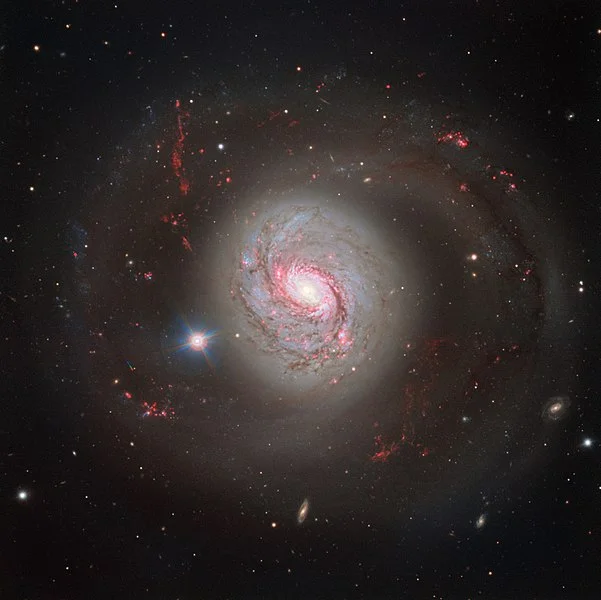
Messier 77 (Cetus A), image: ESO (CC BY 4.0)
Messier 78 (M78)
Messier 78 (NGC 2068) is a reflection nebula located 1,350 light-years away in the constellation Orion. It has an apparent magnitude of 8.3 and an apparent size of 8 by 6 arcminutes. It appears at the intersection of the imaginary lines connecting Betelgeuse with Alnitak and Sirius with Bellatrix.
M78 was discovered by Pierre Méchain in March 1780. It is part of the Orion B molecular cloud complex. The nebula has a radius of 5 light years. It can be spotted in a small telescope on a clear night.
Messier 79 (M79)
Messier 79 (NGC 1904) is a globular cluster located approximately 42,000 light-years away in the constellation Lepus (the Hare). It has an apparent visual magnitude of 7.7 and an angular size of 8.7 arcminutes. It can be found by extending a line from Arneb (Alpha Leporis) through Nihal (Beta Leporis).
The star cluster was discovered by Pierre Méchain on October 26, 1780. It has a physical radius of 53 light-years and an estimated age of 11.7 billion years.
Messier 80 (M80)
Messier 80 (NGC 6093) is a globular cluster that appears roughly halfway between Antares and Acrab in the constellation Scorpius. It shines at magnitude 7.3 from a distance of 32,600 light-years. It has an angular size of 10 arcminutes and a physical diameter of 95 light-years.
M80 is believed to be 13.5 billion years old. It was discovered by Charles Messier on January 4, 1781.
Messier 81 (M81) – Bode’s Galaxy
Messier 81 (NGC 3031) is a grand design spiral galaxy located 11.8 million light-years away in the constellation Ursa Major. It has an apparent magnitude of 6.94 and an apparent size of 26.9 by 14.1 minutes of arc, corresponding to a diameter of 96,000 light-years. It is one of the easiest galaxies in the Messier catalogue to observe.
M81 is the brightest member of the M81 Group, which also includes the Cigar Galaxy (M82). It was named Bode’s Galaxy after the German astronomer Johann Elert Bode, who discovered it on December 31, 1774. It appears near M82 in the sky, about 10 degrees northwest of Dubhe (Alpha Ursae Majoris), the northernmost star of the Big Dipper.
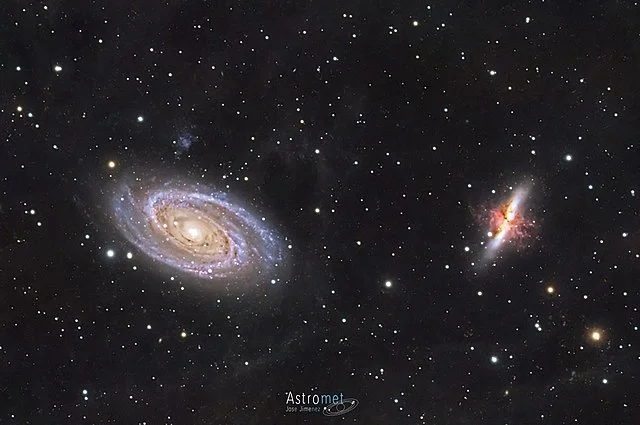
Bode’s Galaxy and the Cigar Galaxy (M81 and M82), image: José Jiménez (CC BY 2.0)
Messier 82 (M82) – Cigar Galaxy
Messier 82 (NGC 3034) is a starburst galaxy appearing edge-on, located 11.4 – 12.4 million light-years away in Ursa Major. It has an apparent magnitude of 8.41 and an apparent size of 11.2 by 4.3 arcminutes. It is famously known as the Cigar Galaxy.
M82 was discovered by Johann Bode on December 31, 1774, along with its larger neighbour M81. It is the second largest galaxy in the M81 Group, with a diameter of 40,800 light-years. The starburst activity in the galaxy is believed to be the result of interaction with M81.
Messier 83 (M83) – Southern Pinwheel Galaxy
Messier 83 (NGC 5236) is a barred spiral galaxy located 14.7 million light-years away in the constellation Hydra. It has an apparent magnitude of 7.6 and an angular size of 12.9 by 11.5 minutes of arc, corresponding to a diameter of 118,000 light-years. It was nicknamed the Southern Pinwheel Galaxy because of its resemblance to the Pinwheel Galaxy (Messier 101) in Ursa Major.
The grand design spiral galaxy was discovered by Nicolas Louis de Lacaille in 1751. It is the dominant member of the M83 Group, a subgroup of the Centaurus A/M83 Group of galaxies.
Messier 84 (M84)
Messier 84 (NGC 4374) is a giant elliptical or lenticular galaxy located 54.9 million light-years away in the constellation Virgo. It lies near the centre of the Virgo Cluster of galaxies.
M84 has an apparent magnitude of 9.1 and an apparent size of 6.5 by 5.6 arcminutes. It appears next to Messier 86 in the sky. Both galaxies are part of Markarian’s Chain, a stretch of galaxies in the core of the Virgo Cluster that can be seen in a small telescope.
M84 was discovered by Johann Koehler on May 5, 1779. Charles Messier discovered the galaxy on March 18, 1781, and included it in his catalogue.
Messier 85 (M85)
Messier 85 (NGC 4382) is a lenticular or elliptical galaxy in the constellation Coma Berenices. It has an apparent magnitude of 9.1 and an angular size of 7.1 by 5.5 arcminutes, corresponding to a spatial diameter of 120,600 light-years. It was discovered by Pierre Méchain on March 4, 1781.
M85 is in the process of interacting with the spiral galaxy NGC 4394 and the small elliptical galaxy MCG 3-32-38. The galaxies are members of the Virgo Cluster.
Messier 86 (M86)
Messier 86 (NGC 4406) is an elliptical or lenticular galaxy located in the centre of the Virgo Cluster in the constellation Virgo. It lies approximately 52 million light-years away and has an apparent visual magnitude of 8.9. The galaxy is part of Markarian’s Chain, along with M84.
M86 was discovered by Johann Koehler on May 5, 1779. Charles Messier discovered the galaxy on March 18, 1781, and listed it in his catalogue.
M86 appears almost exactly halfway between Vindemiatrix (Epsilon Virginis) in Virgo and Denebola (Beta Leonis) in Leo.
Messier 87 (M87) – Smoking Gun Galaxy (Virgo A)
Messier 87 (NGC 4486) is a supergiant elliptical galaxy located 53.5 million light-years away in the Virgo constellation. It is one of the largest galaxies in the local universe. It lies at the centre of the Virgo Cluster.
The galaxy has an apparent magnitude of 8.6 and an apparent size of 7.2 by 6.8 minutes of arc. It has an isophotal diameter of 132,000 light years and a diffuse galactic envelope with a radius of 490,000 light-years.
M87 has a jet of energetic plasma extending at least 4,900 light-years and travelling at a relativistic speed. The galaxy contains a supermassive black hole with a mass billions of times that of the Sun. This was the first black hole to be directly imaged with the Event Horizon Telescope (EHT). The image was released in 2018.
M87 was discovered by Johann Koehler on May 5, 1779. Charles Messier spotted it on March 18, 1781. The galaxy was classified as an extragalactic nebula until 1954.
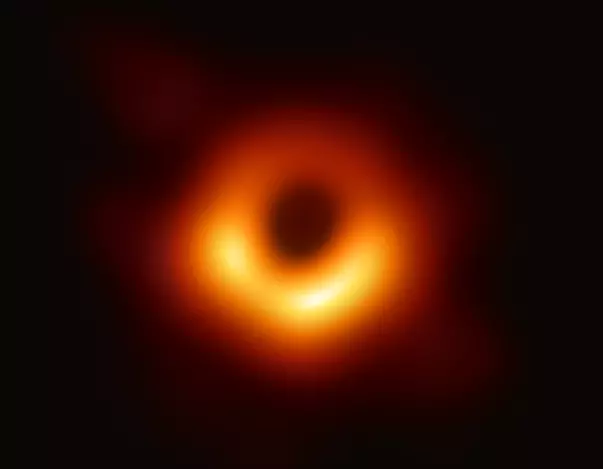
In this image of M87* taken on 11 April 2017 (a representative example of the images collected in a global 2017 EHT campaign), the shadow of a black hole is the closest we can come to an image of the black hole itself, a completely dark object from which light cannot escape. The black hole’s boundary — the event horizon from which the EHT takes its name — is around 2.5 times smaller than the shadow it casts and measures just under 40 billion km across. Image: Event Horizon Telescope (CC BY 4.0)
Messier 88 (M88)
Messier 88 (NGC 4501) is a spiral galaxy located 50 – 60 light-years away in the constellation Coma Berenices. It was discovered by Charles Messier on March 18, 1781. It has an apparent magnitude of 9.6.
The galaxy is a member of the Virgo Cluster. It appears in the same region as Messier 91. It has a Seyfert nucleus and contains a supermassive black hole with a mass of 80 million Suns.
Messier 89 (M89)
Messier 89 (NGC 4552) is an elliptical galaxy in Virgo. It has a visual magnitude of 9.8 and is about 50 million light-years distant from Earth. The galaxy was discovered by Charles Messier on March 18, 1781. It is a member of the Virgo Cluster.
Messier 90 (M90)
Messier 90 (NGC 4569) is an intermediate spiral galaxy in the Virgo Cluster. It lies 58.7 million light-years away in the constellation Virgo. With an apparent magnitude of 9.5 and an apparent size of 9.5 by 4.4 minutes of arc, it can be seen in small telescopes. Charles Messier discovered the galaxy on March 18, 1781.
Messier 91 (M91)
Messier 91 (NGC 4548) is a barred spiral galaxy located approximately 63 million light-years away in the constellation Coma Berenices. The galaxy is a member of the Virgo Cluster and appears in the same area as M88. It was discovered by Charles Messier on March 18, 1781.
M91 has an apparent visual magnitude of 10.2 and an angular size of 5.4 by 4.3 arcminutes. It is the faintest object listed in the Messier catalog.
Messier 92 (M92)
Messier 92 (NGC 6341) is a globular star cluster that lies in the constellation Hercules. It shines at magnitude 6.4 from a distance of 26,700 light-years. It has an angular size of 14 arcminutes, corresponding to a physical radius of 54 light-years.
M92 has an estimated age of 14.2 billion years and is one of the older globular clusters in the Milky Way. It was discovered by Johann Elert Bode on December 27, 1777. William Herschel was the first to resolve individual stars in the cluster in 1783.
Messier 93 (M93) – Critter Cluster
Messier 93 (NGC 2447) is a strongly concentrated open star cluster in the constellation Puppis. It shines at magnitude 6.0 from a distance of 3,380 light-years. It has an apparent size of 10 arcminutes, corresponding to a spatial radius of 10 light-years.
The cluster has a mass of 723 solar masses and an estimated age of 387.3 million years. It was discovered by Charles Messier on March 20, 1781. It appears near the yellow supergiant Azmidi (Xi Puppis) in the sky.
Messier 94 (M94) – Cat’s Eye Galaxy
Messier 94 (NGC 4736) is a spiral galaxy located 16 million light-years away in the constellation Canes Venatici. It has an apparent magnitude of 8.2 and an apparent size of 11.2 by 9.1 minutes of arc. It was discovered by Pierre Méchain on March 22, 1781.
M94 is popularly known as the Cat’s Eye Galaxy or Crocodile Eye Galaxy (Croc’s Eye Galaxy). It appears in the same region as Messier 63. It is the brightest member of the M94 Group of galaxies.
Messier 95 (M95)
Messier 95 (NGC 3351) is a barred spiral galaxy located 32.6 million light-years away in the constellation Leo. It was discovered by Pierre Méchain on March 20, 1781. It has an apparent visual magnitude of 9.7 and an apparent size of 3.1 by 2.9 arcminutes.
M95 is a member of the M96 Group (Leo I Group), a group of galaxies that includes the brighter spiral galaxy Messier 96 and the elliptical galaxy Messier 105. The group appears around a third of the way from Regulus (Alpha Leonis) to Denebola (Beta Leonis).
Messier 96 (M96)
Messier 96 (NGC 3368) is an intermediate spiral galaxy located approximately 31 million light-years away in the constellation Leo. It has an apparent size of 7.6 by 5.2 arcminutes. It was discovered by Pierre Méchain on March 20, 1781.
M96 is the brightest member of the M96 Group, which also includes M95, M105 and at least nine fainter galaxies.
Messier 97 (M97) – Owl Nebula
Messier 97 (NGC 3587) is a planetary nebula located 2,030 – 2,800 light-years away in the constellation Ursa Major. The nebula appears in the same region as the barred spiral galaxy Messier 108, just over 2.5 degrees southeast of Merak (Beta Ursae Majoris).
The Owl Nebula was discovered by Pierre Méchain on February 16, 1781. With an apparent magnitude of 9.9 and an apparent size of 3.4 by 3.3 arcminutes, it can be observed in a small telescope in good conditions. It has an estimated age of 8,000 years.
Messier 98 (M98)
Messier 98 (NGC 4192) is an intermediate spiral galaxy located approximately 44.4 million light-years away in the constellation Coma Berenices. It appears 6 degrees east of Denebola (Beta Leonis) in the neighbouring Leo. The galaxy was discovered by Pierre Méchain on March 15, 1781, along with Messier 99 and Messier 100.
M98 is a member of the Virgo Cluster. It has an apparent magnitude of 10.1 and an apparent size of 9.8 by 2.8 arcminutes. It is believed to have interacted with M99 around 750 million years ago. The galaxies are now separated by 1.3 million light-years.
Messier 99 (M99) – Coma Pinwheel Galaxy (St. Catherine’s Wheel)
Messier 99 (NGC 4254) is a spiral galaxy in Coma Berenices. It has an apparent magnitude of 9.9 and is about 45.2 million light years distant from Earth. The galaxy has an apparent size of 5.4 by 4.7 arcminutes. Like the nearby M98, it is a member of the Virgo Cluster. It was discovered by Pierre Méchain on March 15, 1781.
The spiral pattern of M99 was first identified by the English astronomer William Parsons, 3rd Earl of Rosse, in 1846. The Coma Pinwheel was one of the first spiral galaxies in which this pattern was seen.
Messier 100 (M100) – Mirror Galaxy
Messier 100 (NGC 4321) is an intermediate grand design spiral galaxy located 55 million light-years away in the constellation Coma Berenices. The starburst galaxy appears in the same region as M98 and M99. It is one of the brightest and largest members of the Virgo Cluster of galaxies.
The Mirror Galaxy was discovered by Pierre Méchain on March 15, 1781. It has an apparent visual magnitude of 9.3 and an apparent size of 7.4 by 6.3 arcminutes, corresponding to a spatial diameter of 166,100 light-years. The galaxy hosted seven supernovae observed in the 20th and 21st centuries.
Messier 101 (M101) – Pinwheel Galaxy
Messier 101 (NGC 5457) is an intermediate spiral galaxy located 20.9 million light-years away in the constellation Ursa Major. It has an apparent magnitude of 7.9 and an apparent size of 28.8 by 26.9 arcminutes. The galaxy appears above the Big Dipper’s handle and forms a triangle with Alkaid (Eta Ursae Majoris) and Mizar (Zeta Ursae Majoris).
The Pinwheel Galaxy was discovered by Pierre Méchain on March 27, 1781. It contains 1 trillion stars and has a diameter of 170,000 light-years.
M101 is the brightest galaxy in the M101 Group, which also includes the companion galaxies NGC 5204, NGC 5474, NGC 5585, and NGC 5477.
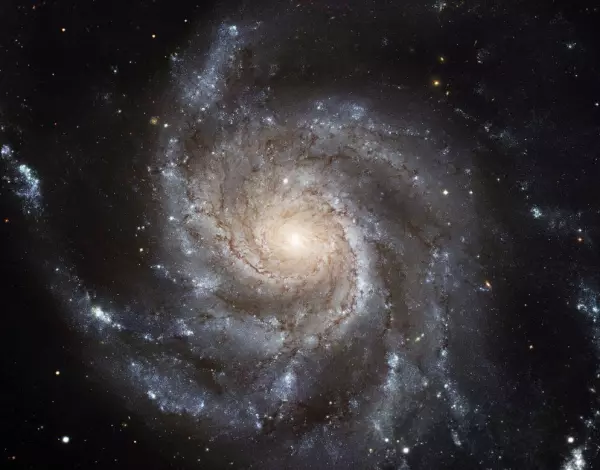
The galaxy Messier 101 (M101, also known as NGC 5457 and also nicknamed the Pinwheel Galaxy) lies in the northern circumpolar constellation, Ursa Major (The Great Bear). This is one of the largest and most detailed photo of a spiral galaxy that has been released from Hubble. The galaxy’s portrait is actually composed of 51 individual Hubble exposures, in addition to elements from images from ground-based photos. Image: Image: European Space Agency & NASA. Project Investigators for the original Hubble data: K.D. Kuntz (GSFC), F. Bresolin (University of Hawaii), J. Trauger (JPL), J. Mould (NOAO), and Y.-H. Chu (University of Illinois, Urbana); Image processing: Davide De Martin (ESA/Hubble); CFHT image: Canada-France-Hawaii Telescope, J.-C. Cuillandre/Coelum; NOAO image: George Jacoby, Bruce Bohannan, Mark Hanna, NOAO, AURA, NSF (CC BY 4.0)
Messier 102 (M102) – Spindle Galaxy
Messier 102 (NGC 5866) is an edge-on lenticular galaxy located 50 million light-years away in the northern constellation Draco. It has an apparent magnitude of 9.9 and an apparent size of 4.7 by 1.9 arcminutes, corresponding to a spatial diameter of 76,000 light-years.
The Spindle Galaxy was probably discovered by Pierre Méchain in 1781 and independently spotted by William Herschel in 1788. It is the one of the brightest members of the NGC 5866 Group, which also includes NGC 5879 and NGC 5907.
The object listed as Messier 102 has not been unambiguously identified as NGC 5866, but most sources believe that the two are the same object. M102 was discovered by Pierre Méchain, who retracted his discovery after the publication of the Messier catalogue, stating that it was a duplicate observation of the Pinwheel Galaxy (M101). The Spindle Galaxy and the Pinwheel Galaxy lie in the same region of the sky, between the tail of Draco and the handle of the Big Dipper.
Messier 103 (M103)
Messier 103 (NGC 581) is a small open cluster located 9,400 light-years away in the constellation Cassiopeia. The star cluster appears in the region of Cassiopeia’s W, close to Ruchbah (Delta Cassiopeiae). It was discovered by Pierre Méchain on March 27, 1781.
M103 has an apparent magnitude of 7.4 and an apparent size of 6 arcminutes, corresponding to a diameter of about 15 light-years. It has an estimated age of only 12.6 – 25 million years.
Messier 104 (M104) – Sombrero Galaxy
Messier 104 (NGC 4594) is a peculiar galaxy located 31.1 million light-years from the solar system in the constellation Virgo. It is not a member of the Virgo Cluster. It lies near the border with Corvus and can be found using the stars of Spica’s Spanker. M104 was discovered by Pierre Méchain on May 11, 1781.
The Sombrero Galaxy has an apparent magnitude of 8.0 and an apparent size of 9 by 4 arcminutes. The galaxy is 105,400 by 56,900 light-years across. It has a large bulge and a prominent dust lane. It has a LINER nucleus and contains a supermassive black hole with an estimated mass of 1 billion solar masses.
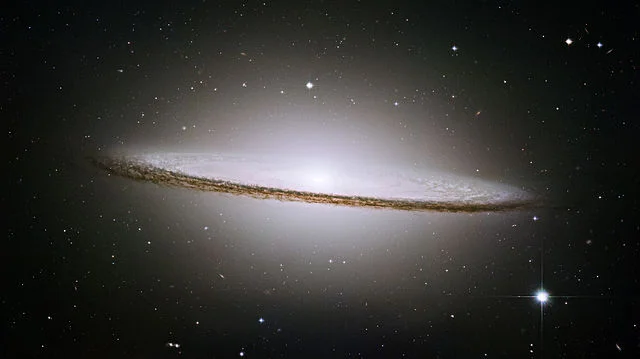
The famous Sombrero Galaxy (M104) is a bright nearby elliptical galaxy. The prominent dust lane and halo of stars and globular clusters give this galaxy its name. Something very energetic is going on in the Sombrero’s center, as much X-ray light has been detected from it. This X-ray emission coupled with unusually high central stellar velocities cause many astronomers to speculate that a black hole lies at the Sombrero’s center – a black hole a billion times the mass of our Sun. Image: NASA/ESA and The Hubble Heritage Team (STScI/AURA) (CC BY 4.0)
Messier 105 (M105)
Messier 105 (NGC 3379) is an elliptical galaxy in the constellation Leo. It is a member of the Leo I Group (M96 Group), along with Messier 96 and Messier 95. M105 has an apparent magnitude of 9.3 and lies 36.6 million light-years away. It has an apparent size of 5.4 by 4.8 arcminutes.
M105 was discovered by Pierre Méchain on March 20, 1781, along with M95 and M96.
Messier 106 (M106)
Messier 106 (NGC 4258) is an intermediate spiral galaxy located 23.7 million light-years away in the constellation Canes Venatici. It was discovered by Pierre Méchain in July 1781. It has an apparent visual magnitude of 8.4 and an angular size of 18.6 by 7.2 arcminutes, corresponding to a physical diameter of 135,000 light-years.
M106 is similar in size to the better-known Andromeda Galaxy. It appears in the region between Cor Caroli (Alpha2 Canum Venaticorum) in Canes Venatici and Phecda (Gamma Ursae Majoris) in Ursa Major. It has a possible companion, the edge-on spiral galaxy NGC 4217.
Messier 107 (M107) – Crucifix Cluster
Messier 107 (NGC 6171) is a loose globular cluster in the constellation Ophiuchus. It shines at magnitude 7.9 from a distance of 20,900 light-years. The cluster appears 2.5 degrees from Zeta Ophiuchi in the sky. It has an apparent size of 10 arcminutes, corresponding to a spatial radius of 30 light years.
M107 has an estimated age of 13.95 billion years. It was discovered by Pierre Méchain in April 1782.
Messier 108 (M108) – Surfboard Galaxy
Messier 108 (NGC 3556) is a barred spiral galaxy located 46 million light-years away in the constellation Ursa Major. The galaxy appears near Merak (Beta Ursae Majoris) and the planetary nebula Messier 97 (the Owl Nebula). It was discovered by Pierre Méchain on February 19, 1781 and added to the Messier catalogue by Owen Gingerich.
M108 has an apparent visual magnitude of 10 and an apparent size of 8.7 by 2.2 arcminutes. It is an isolated member of the Ursa Major Cluster of galaxies, which also includes the spiral galaxies NGC 3631, NGC 3593 and NGC 3726.
Messier 109 (M109) – Vacuum Cleaner Galaxy
Messier 109 (NGC 3992) is a barred spiral galaxy located approximately 67.2 million light-years away in the constellation Ursa Major. It appears very close to Phecda (Gamma Ursae Majoris) in the sky. It was discovered by Pierre Méchain in 1781.
M109 has an apparent magnitude of 9.8 and an angular size of 7.6 by 4.7 arcminutes. It is the most distant object listed in the Messier catalogue, followed by the barred spiral galaxy M91.
M109 is the brightest galaxy in the M109 Group, which also includes NGC 3718, NGC 3726, and NGC 3729. It has three smaller satellite galaxies.
Messier 110 (M110)
Messier 110 (NGC 205) is a dwarf elliptical galaxy located 2.69 million light-years away in the constellation Andromeda. It is a satellite of the much brighter and larger Andromeda Galaxy (Messier 31). M110 has an apparent magnitude of 8.5 and an apparent size of 21.9 by 11 minutes of arc.
M110 was discovered by Charles Messier on August 10, 1773, too late to include it in his catalogue. The galaxy was added to the Messier catalogue by Kenneth Glyn Jones in 1967.
